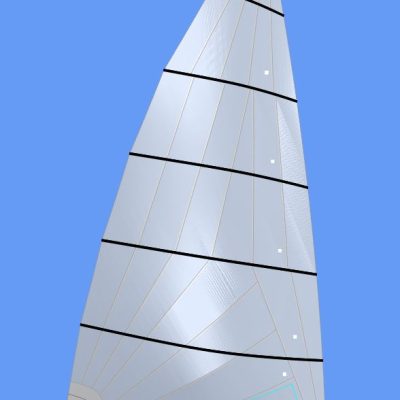-

-

-

-
Last Products
-
 Squib Jib B3
$732.00
Squib Jib B3
$732.00
-
 Squib Mainsail B3
$1,061.40
Squib Mainsail B3
$1,061.40
-
 Solo Main Code 7L
Solo Main Code 7L
$1,342.01$1,140.71
-
Solo Setup Perspective – Ben McGrane from the RIB.
It’s interesting how the setup in the class has evolved in more recent years going through a period of extreme settings and then settling back down with a fairly consistent mast heel position and 5-10mm changes in forestay. When I sailed the 2006 nationals the majority of the fleet were still running dacron sails, and the boats were far simpler with only the 3 basic controls of kicker, cunningham and outhaul. Unsurprisingly as sail design has evolved and materials improved, what can be achieved with the sail flying shape has meant a period of testing and the class went through a busy period of experimentation with settings to get to where we are today in a position where things are quite simple again.
So what are we trying to do in our settings today?
With a fairly settled heel position in the class again the general rule now seems to be to increase rake in the windier conditions which is achieving a couple of things:
All the above are useful in conditions when it is windy but through the time spent following Richie this winter it also became apparent the chocks could be used to a much greater extent as a way of changing how the sails behaves. From outside the boat it is remarkable how soon the Solo reaches the point of requiring to depower, in 12 knots Richie was on his aft rake setting and had the board well raised, boom going outside the quarter and so the question became where do you go from here?
Chock vs. Rake
There is definitely the option to go further back with the rake, it all makes getting under the boom harder, the shrouds tension reduces and the negative here can be a lose of reaching performance. There is also the point you can only pull the board up so far which in most boats you wouldn’t want to go past 45 deg and you need to keep these 2 elements in balance for an easy to sail boat.
Through changing the amount of chock we were able to completely transform the way the sail looked and vastly improve the behaviour of the boat. Key for me was I didn’t like the look of the very hard kicker set up with a firm leech with the boom quickly ends up outside the quarter, it requires more sailor input (far more mainsheet) and the rig doesn’t give a lot of input to helping the boat sail fast. Using the max bend starvation crease as a datum we were able to go through 5mm changes to adjust the appearance of the sail. Remove 5mm of chock bring the kicker back to just the point of the starvation crease and then repeated again for another 5mm removed, so the only adjustment was the relationship of the chock and kicker.
What happens as the chock is reduced?
The lower mast bend increases giving a flatter lower half of the sail but with the forestay unchanged the mast tip also pivots aft reducing leech tension. You can’t carry as much kicker tension as before as the lower mast will overbend but as the mast is already able to bend without the chock there is less requirement for kicker. The overall outcome is a flatter sail with more twist.
The nice thing with this is the twisted setup brings the boom back towards the quarter of the boat so you can drive height off the lower leech, the sail is more open up top. My view is the goal has to be to flatten and depower in the head and then drive off the lower part of the sail.
Early days experimenting with this side of things but it will be interesting as Richie does more testing to see how far he can take it and we still need to take this up the wind range further where I feel it could make more of a difference. Give it a go next time you are out sailing and overpowered with the boom outside the quarter, reduce chock and see what you think, just be careful to then not get too carried away on the kicker.
Photos below of changes in Richie’s setup.
No chock. A step too far perhaps for the wind strength which is down slightly compared to the other 2 photos. Boom on the quarter, starvation crease just visible at the inboard end of the bottom batten. Further increase in twist with the head now even further open. Would like to see this setup in more pressure with the introduction of cunningham as well.